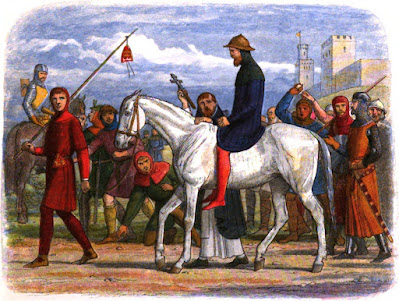Over the last few years, a group of volunteers at Pontefract Castle has been publishing ‘On this day in history’ articles for the castle’s Facebook page. In this special guest post, they explain how the project came about and introduce their exciting new website.
By Kevin Wilson and Alan Archer
This project developed out of a desire to bring the fascinating histories of both Pontefract and Sandal Castles to a much wider audience. The 'on this day' Facebook articles were tremendously well received, with at times more than 10,000 hits for any particular post. A good example of one of the most popular posts was in relation to the death of Thomas, Earl of Lancaster:
“Following the defeat of Thomas, Earl of Lancaster, lord of Pontefract, and his supporters at the Battle of Boroughbridge on March 16th 1322, Thomas was tried and condemned in the Great Hall at Pontefract Castle. He was denied the opportunity to speak in his defence and was sentenced to be hanged, drawn and quartered. The sentence was commuted to beheading because Thomas was the king’s cousin and, it is rumoured, due to the intercession of Queen Isabella. He was taken on a mule to St Thomas’ Hill - as it has since been known - and executed on the 22nd March 1322 in sight of his castle and whilst facing Scotland (symbolic of his alleged treasonable correspondence with the Scots.) ...”
Similar interest has been shown in the history of Sandal Castle, with one of the most popular entries relating to the Battle of Wakefield on 30th December 1460:
“On 30th December 1460, the Battle of Wakefield was fought on the plain ground between Sandal Castle and the town of Wakefield i.e. to the north of Sandal Castle. This battle has often been overlooked in history mainly due to its short duration (one to two hours) and the number of combatants (about 30,000) when compared against some of the great battles of the era at St Albans, Towton, and Barnet. However, this battle changed the course of English history as the Yorkists were routed, losing 2,500 men. Richard, Duke of York himself was killed and his head subsequently displayed on Micklegate Bar in York …”
 |
| Richard, Duke of York memorial on Manygates Lane, Wakefield SMJ / Richard of York Memorial https://upload.wikimedia.org/wikipedia/commons/0/0a/Richard_of_York_Memorial_-_geograph.org.uk_-_858000.jpg |
As a result of the interest shown in these articles, it was clear there was a real thirst for knowledge about the history of Pontefract’s royal castle and its neighbour, Sandal. In seeking to build upon this interest and provide a permanent and repeating record of historical events at both Pontefract and Sandal Castles, we developed www.pontefractsandalcastles.org.uk, which aims to tell a day-by-day history of both castles through the centuries. The entries on this site have been thoroughly researched through the reading of historical books and texts, articles, ancient chronicles, websites and the contributions of published historians.
 |
| The Keep, Pontefract Castle |
Pontefract Castle was originally built in 1070 by the de Lacy family, who had journeyed to England with William the Conqueror. The castle was first built of timber but over time a stone fortress was constructed and added to.
The first castle at Sandal started to be built in 1107 at Lowe Hill by the de Warenne family, who also arrived with the Norman Conquest. In the early 13th century, a more defensible castle was built at the site we see today. The castle had a compact but very secure design.
 |
| Sandal Castle |
The histories of the two castles are inextricably linked. Their story is the story of medieval England: from their initial development as motte and bailey castles built on lands granted to Norman barons who had supported William of Normandy in his conquest of England, through Magna Carta, the local and baronial wars of Thomas of Lancaster, the Wars of the Roses, the English Civil Wars, and the castles' destruction in its immediate aftermath.
However, this is a story that has often been overlooked, and through the new website, we hope to bring the histories of these two great castles to a wholly new audience. With Pontefract being the ‘Key to the North’ and Sandal being the site of the death of the ‘heir’ to the throne, Richard Duke of York, as well as the site of Richard III’s ‘Council of the North’, this is a fascinating narrative that deserves to be more widely known.
We actively encourage feedback and contributions to our website through the ‘Contact Us’ button on the right of the front page of the website.
A big thank you to Kevin and Alan and the fantastic volunteer researchers team for this guest post and all their work on Facebook. We wish them the best of luck with the new website.
To find out more about Sandal Castle's history and recent improvements to the site, including brand new interpretation, check out Sandal Castle: from noble beginnings to picturesque ruins


No comments:
Post a Comment
We would love your comments - though they may take a day or two to appear.